eLearning
finding and sharing information
Author: Harold Jarche
Go to Source
One of the challenges we face in our professional and personal lives is making sense of the flow of information that passes by us each day and then aligning that with our current priorities and challenges. The seek > sense > share framework of personal knowledge mastery is a simple method to help us stay focused in our sensemaking. The image below shows how information and knowledge can flow when people develop filters to seek information, take time and effort to make sense of it, and then share appropriately, often adding value to what they share.

From Finding to Sharing
Establishing a few procedures can simplify the finding and sharing of information, at work, in your communities, or through your knowledge networks.
- Machine filters allow information to be pushed to us. They can be email lists, news feeds, blogs, and paid sources of insight. Tools such as RSS feed readers reduce the cognitive load of finding information.
- We can connect with people who publish their thoughts and engage with them in person — but often through social media — given space and time restrictions. Professional social networks and communities of practice are prime venues for seeking human filters to help us make sense, especially in fields where we lack deep knowledge.
- When information passes through our machine and human filters — which should be regularly reviewed & revised — we can quickly determine if it is important and/or urgent. If it is urgent we may quickly add some value, such as our analysis of the information, and then share it to our networks or teams.
- If information is important we can file it away for later retrieval when the time is right. This requires establishing some methods for personal or team filing. A social booking tool like Diigo is one example.
- There are many ways to add value to information. It comes down to what is appropriate for you as well as the intended audience. Just reading an entire article ensures that you have covered all the points. A summary can then add value for others to determine if they should read the whole article.
- Discerning when, where and how best to share requires an understanding of context and culture. Heuristics are often better than rules in determining how best to share information.
- As part of sharing we should solicit considered feedback. Inside an organization this can be part of everyone’s regular work. Outside the organization good feedback is often the result of good work. If something provokes thinking, readers and viewers may be more willing to provide feedback. This back and forth can develop trust over time so that more complex information can be shared.
- Engaging in regular discussions with fellow professionals can sharpen our thinking. Communities of practice provide a trusted space for these.
- Published information is one result of these procedures. For example, the chats, questions, and conversations between employees can be collected and refined to inform organizational search engines. Self-published works, like blogs, can contribute to official documents like white papers and brochures. The decision to publish internally or externally depends on the context and culture but the latter can help make the entire network smarter.

